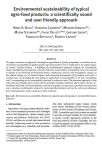El Bilali H., Calabrese G., Iannetta M., Stefanova M., Paoletti F., Ladisa G., Bottalico F., Capone R. (2020). Environmental sustainability of typical agro-food products: a scientifically sound and user friendly approach. New Medit, 01/06/2020, vol. 19, n. 2, p. 69-83.
https://doi.org/10.30682/nm2002e
https://doi.org/10.30682/nm2002e
| Titre : | Environmental sustainability of typical agro-food products: a scientifically sound and user friendly approach (2020) |
| Auteurs : | H. El Bilali ; G. Calabrese ; M. Iannetta ; M. Stefanova ; F. Paoletti ; G. Ladisa ; F. Bottalico ; R. Capone |
| Type de document : | Article |
| Dans : | New Medit (vol. 19, n. 2, June 2020) |
| Article en page(s) : | p. 69-83 |
| Langues : | Anglais |
| Langues du résumé : | Anglais |
| Catégories : |
Catégories principales 04 - DEVELOPPEMENT LOCAL ET REGIONAL ; 4.3 - Appellations liées au Territoire. Produits du Terroir. QualitéThésaurus IAMM PRODUIT ALIMENTAIRE ; BIODIVERSITE ; PROGRAMME DE DEVELOPPEMENT ; INDICATEUR DE DEVELOPPEMENT DURABLE ; INDICATEUR ENVIRONNEMENTAL ; QUALITE ; DURABILITE ; UTILISATION DES TERRES ; CHANGEMENT CLIMATIQUE ; MOYEN DE PRODUCTION AGRICOLE ; GESTION DES DECHETS ; ITALIE |
| Résumé : | The paper introduces an approach, developed in Agriculture & Quality programme, to evaluate the environmental sustainability of Apulian quality agro-food products that is integrated in the regional quality scheme “Quality Products”. It highlights the methodological approach adopted, the sustainability themes identified and the indicators selected. Indicators measurable at the farm/firm level were selected in relation to the following environmental themes: biodiversity, land use and management, energy use and climate change, use of chemical inputs, and responsible management of by-products and waste. A scoring scale was developed for each indicator; going from 0 (unsustainable) to 10 (very sustainable) with 5 corresponding to the sustainability threshold or reference value. The presented approach is both robust and user friendly and is in line with the principle entailing continuous improvement; the key sustainability thresholds will be periodically reviewed and updated. It represents a practical and innovative way to develop an information scheme for typical agri-food products and can be, with some refinement and contextualisation, easily scaled up to other territories. |
| Cote : | En ligne |
| URL / DOI : | https://doi.org/10.30682/nm2002e |







